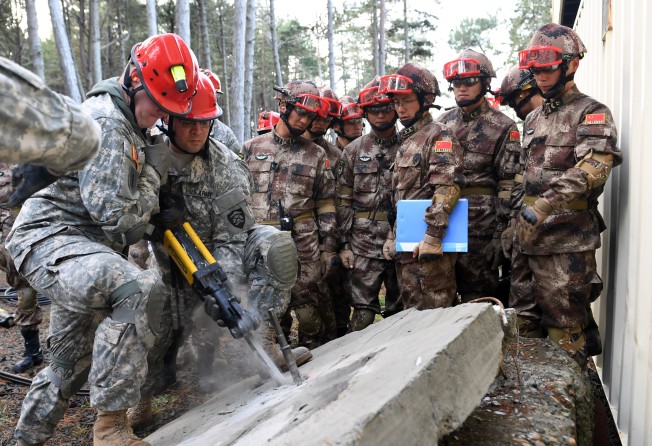Chinese troops head to Hawaii for joint disaster relief exercise with US military
- Humanitarian training highlights one area where the two sides can still cooperate despite tensions over trade war and South China Sea
- US ambassador also insists Chinese students remain welcome in America, but observers stay cautious about overall state of relations

The Chinese and US militaries will take part in a joint disaster relief training exercise in Hawaii this month.
China’s defence ministry said that more than 200 personnel from the People’s Liberation Army’s Eastern Theatre Command and the United States Army Pacific would take part in the drill that starts on Thursday and runs until November 24.
Similar exercises have taken place every year since 2013 – last year’s was held in the eastern Chinese city of Nanjing – and their continuation represents a rare example of efforts to build bridges between the two sides.
The two countries have also heralded recent cooperation in areas such as the international trade in opioids, but observers said these efforts would not be enough on their own to overcome the tensions caused by the trade war and their mutual suspicions.
While the two militaries are cooperating on the humanitarian drills, China’s growing strategic ambitions in other areas have caused increasing concern.
Last year the US disinvited China from the multinational Rim of the Pacific Exercise, citing China’s “continued militarisation of the South China Sea”, where it has been expanding its presence and military infrastructure in disputed waters.
Another source of tension has been the growing scrutiny visa applications by Chinese students and academics have faced due to US security concerns.
But on Monday an article by US ambassador Terry Branstad for China Youth Daily said that America still welcomed Chinese students to its universities.
An accompanying commentary in the newspaper, the official journal of the Communist Youth League, said Branstad’s article “bears important significance in relieving tensions between the two countries in certain fields, and China welcomes it”.
Despite the upbeat tone of the newspaper, Chinese analysts remained cautious about the state of overall relations between the two sides.
Shi Yinhong, a professor of international relations at Renmin University and a government adviser, said there had been “signs of some tentative results” since last month’s trade talks at the White House prompted US President Donald Trump to predict the two sides would be able to agree on a “phase one” trade deal within weeks.
But Shi warned: “Frictions are grave on the Hong Kong issue, for example, and possibly on Taiwan, depending on the result of the election there early next year.”
Lu Xiang, a US affairs specialist at the Chinese Academy of Social Sciences, said that while there was scope for cooperation in some areas, in others – for example, visa controls – the US “talks the talk, but does not walk the walk”.
Lu also pointed to recent anti-China rhetoric from the likes of US Vice-President Mike Pence and Secretary of State Mike Pompeo – who recently warned that Beijing was hostile to Western values – as another reason for China to remain cautious about US intentions.
“Despite serious confrontation in some areas, it’s good to keep cooperation in some other areas, and this is China’s long-term position … It will do good over the long run to keep cooperating in a small range of areas,” Lu said.
One example of long-term cooperation cited by Lu was the efforts to control to supply of fentanyl, the drug at the centre of the US opioid crisis.
Last week in a rare joint public statement, the two countries gave details of the first major joint operations involving law enforcement agencies in both countries after one trafficker in China was given a suspended death sentence and eight others were jailed.
While Trump initially suggested that an interim trade deal could be reached within three to five weeks of the October 11 White House talks, he caused fresh uncertainty on Friday when he stated that he had not yet agreed to roll back tariffs on Chinese products – a key demand for Beijing.
The US president had previously indicated that following the signing of the “phase one” deal work would immediately resume on the next phase of the talks covering thornier topics.
Shi said: “It looks like there are still big controversies in every key item of the deal, such as China’s purchase of agricultural products, concrete arrangements to improve intellectual property protection and the opening up of financial markets.”
However, one small breakthrough was made last week when China became only the third country in the world permitted to export catfish to America after it was able to satisfy Washington that the two nations’ regulatory systems were sufficiently aligned.